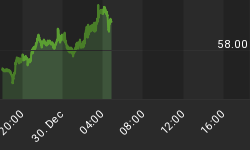Our long-time readers know we expect gold to make a marginally lower low in coming months, but we penned this article to examine the alternative. Gold has been in a corrective formation since 2011, and it made a significant low in June 2013. What would be the path forward if that low remains unchallenged (for now) and price bounces from its present level? That scenario will probably lead to frustration for those trying to get in on an extended long trade.
The chart below, which we have labeled as the alternate scenario, presents the technical case for a bounce. If price can overcome resistance provided by the downward-sloping channel, then there are attractive Fibonacci targets above. The upward-sloping parallel in the vicinity of $1,530 to $1,560 also could call for at least a test, as it was previously support. In addition, note that the empirical market cycle is near a low, meaning that any continued decline in price would be working against a headwind.

From an Elliott Wave perspective, the move down from 2011 also counts reasonably well as a correction of the 3-3-5 format. Typically, that would signal the completion of a corrective pattern, suggesting that price should rise in an impulsive wave that would lead to new all-time highs. Not so fast.
The key clue that the large correction may not be over, and that the scenario presented above may lead gold enthusiasts astray, lies in the structure of the bounce from June of this year. An impulsive move out of a seated low would be expected to start with a five-wave minor impulsive move, but the structure of the bounce from June to August clearly consists of three waves. Thus, the bounce itself is probably part of a corrective move, nested inside the large correction from 2011. An advance from here, even if it produces a new high for the year, should be viewed merely as the upward 'c' wave of that correction. That could certainly produce a trade from here, but the bounce would be a pyrrhic victory for long-term gold bulls.
The caveat that some gold bulls might suggest is that price could have begun rising in a sneaky leading diagonal formation, which would consist of incremental three-wave advances and setbacks. In summer and autumn of this year, we might have seen the first advance and the first setback. While this is technically possible, we believe the scale of the potential leading diagonal looks wrong in relation to the decline from October 2012. The prospect of a rising leading-diagonal is the lowest on our list of possible scenarios.
Thus, if price succeeds in making new highs on the year, that most likely would foretell an eventual downward move into 2014 or later, which would take price below the 2013 low.
In contrast, our primary scenario calls for gold to complete its big correction sooner than that. This view counts the move down from the late-2012 high slightly differently, considering it as an ending diagonal that isn't quite finished yet. It would still need one (or possibly two) marginally lower lows.

Our primary scenario would have gold moving into a low that approximately coincides with the trough of the cycle, to be followed by upswing cycle pressure. Gold is presently not far from resistance provided by the downward-sloping channel and Fibonacci retracement levels, and its response to those levels may serve as confirmation of its desire to test lower. Another thing that would help confirm the downward path would be if the U.S. Dollar finds support near its present area and amid current extreme Dollar-bearish sentiment.
If gold succeeds in making one or two marginally lower lows soon, while remaining above the all-important support of $1,103.40, then we should see price rise in a powerful fifth wave that will eventually surpass the 2011 all-time high.
















